CAC's new HR125 remote sensing Fourier transform spectrometer (pictured in header), located in the Molecular Horizons lab, takes its first solar spectrum!
July 2021
What's cool
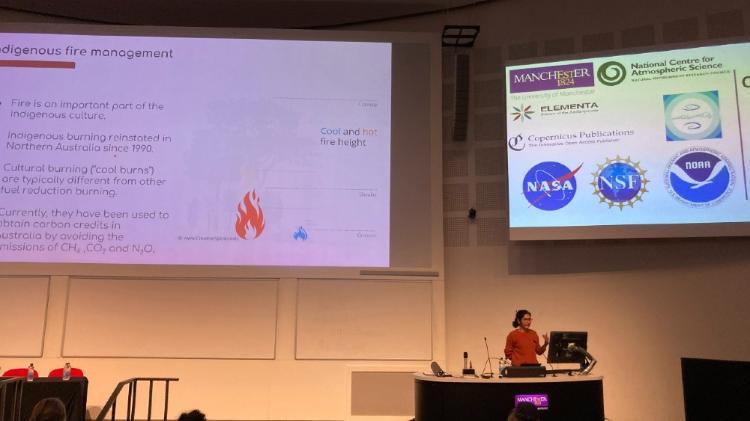
Shyno Susan John presented “Impact of indigenous fire management on the annual cycle of carbon monoxide over Northern Australia"
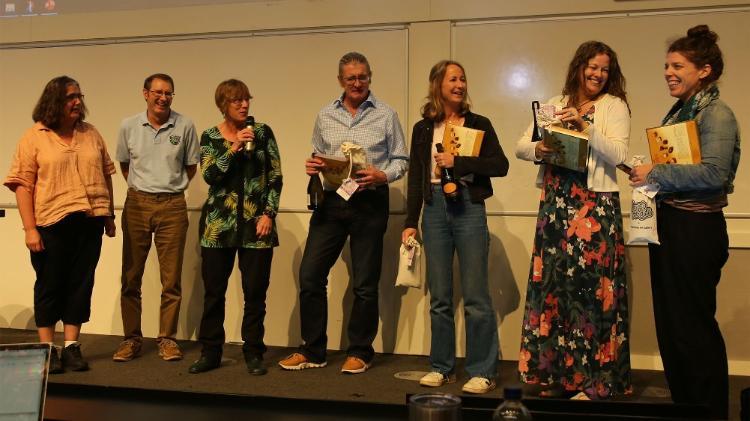
At the conference CAC was well represented by two great talks
What's cool 2022
- Dave Pollard, an Atmospheric Scientist at the National Institute for Weather and the Atmosphere (NIWA, NZ), visited Wollongong for a week following the AirCore campaign to Broken Hill. Dave brought over two EM27 solar remote sensing instruments, one belonging to him and the other to David Noone (University of Auckland). The instruments will run side-by-side with the UOW EM27 and HR125 solar remote sensing instruments for the coming months.
- CAC members took place in events across campus across Global Climate Change Week. Nicholas Deutscher and Jack Simmons presented on CAC greenhouse gas measurements using a variety of techniques from low-cost sensors to high resolution FTIR spectrometers as part of the SMAH Faculty ‘Science and Climate Change Walk’ across campus. Jenny Fisher and Jack Simmons hosted a panel discussion titled ‘Intersecting Issues: climate change equity and justice’ featuring panellists doing climate and equity related research across all UOW faculties.
- CAC students Stephanie Cowling and Lewis Roso submit their Honours theses! Well done! Theses are titled “Assessing the influence of meteorological conditions and terrestrial contaminants on new particle formation processes and events in the Southern Ocean” by Stephanie Cowling and “Can the Impact of COVID-19 Lockdowns on Trace Gas Concentrations in Melbourne be Detected at Kennaook/Cape Grim?” by Lewis Roso. Thanks to external supervisors Melita Keywood, Ruhi Humphries, Scott Chambers, Alan Griffith and Alastair Williams and everyone else who helped during their Honours year.
- Clare Murphy heads to Manchester to chair the International Global Atmospheric Chemistry Scientific Steering Committee meeting ahead of the joint IGAC-ICACGP conference.
At the conference CAC was well represented by two great talks: one by Shyno Susan John entitled “Impact of indigenous fire management on the annual cycle of carbon monoxide over Northern Australia” and one by Jhonathan Ramirez Gamboa called: “Are SO2 and NOx driving factors for new particle formation over rural areas in South-east Australia?” as well as posters by Stephen MacFarlane called “Impacts of Aromatic Chemistry on the Global Atmosphere” and Clare Murphy entitled “ A day in the life of a Scribbly Gum Tree -COALA-2020 campaign”. In addition, Adhitya Sutresna from the University of Melbourne presented a poster based on COALA-2020 data: “Evaluating biomass burning organic aerosol markers in ToF-ACSM data using a capture vapouriser: Case study from the COALA-2020 campaign”
There was also a chance to enjoy some social time and catch up with past UOW students too, including Rebecca Buchholz (now at NCAR) and Max Desservettaz (now at the Cyprus Institute).
- David Griffith attended two international meetings in the Netherlands, the European Integrated Carbon Observing System (ICOS) Science conference in Utrecht and WMO/GAW Greenhouse Gas Measurement Techniques (GGMT) meeting in Wageningen. At the latter he also took part in GGMT’s Scientific Advisory Group for the last time, representing TCCON, before handing over to Dr. Thorsten Warneke, University of Bremen.
- Nicholas Deutscher, Travis Naylor, David Griffith, Clare Murphy and Jack Simmons were joined by colleges from the National Oceanic and Atmospheric Administration (NOAA, US) and the National Institute of Weather and Atmosphere (NIWA) to undertake the first ‘AirCore’ measurements in Australia in Broken Hill, western NSW. This technique involves launching a long, thin tube to 30 km above the earth on a weather balloon and collecting a continuous air sample on as the tube falls to earth via parachute. This sample is then analysed for greenhouse gas concentrations, giving a vertical profile of the atmosphere. This campaign was covered in the local ABC news.
- A paper describing measurements taken during the COALA campaign in January 2020 by CAC members Jack Simmons, Clare Murphy, Travis Naylor, David Griffith and Jhonathan Ramirez-Gamboa titled “Bushfire smoke plume composition and toxicological assessment from the 2019–2020 Australian Black Summer” was published in the journal Air Quality, Atmosphere & Health.
- Jhonathan Ramirez Gamboa submits his PhD thesis entitled “Improving our knowledge of Volatile Organic Compounds over south-east Australia”. Congratulations Jhonathan!
- Clare Murphy was interviewed by the Guardian Australia and Nature for comments on the paper in Scientific Reports “Australian wildfires cause the largest stratospheric warming since Pinatubo and extends the lifetime of the Antarctic ozone hole” by Damany‑Pearce et al., 2022.
- Jenny Fisher and PhD student Dominique Kpokro both made presentations at the International Conference on Mercury as a Global Pollutant.
- Clare Murphy was interviewed by the ABC’s PM program on the potential air quality impacts of a proposed petrochemicals, hydrogen and fertiliser production precinct just three kilometres from suburban Palmerston and nine kilometres from Darwin suburbs.
- PhD student Jhonathan Ramirez Gamboa presented a talk about the atmospheric chemistry of VOCs at the SMAH research forum.
- Nicholas Deutscher is on the Scientific Programme Committee for the 17th International Workshop on Greenhouse Gas Measurements from Space.
- CAC had a strong presence at the annual TCCON/NDACC meetings with presentations made by Nicholas Deutscher, Nicholas Jones, Clare Murphy (Paton-Walsh) and David Griffith.
- Nicholas Deutscher hosted some Year 12 students and (hopefully!) CAC students of the future on a lab tour as part of Discovery Day.
- Susan John visits a field site on the south coast of NSW to make measurements of soil CO2 flux, working with SEALS honours student Jessica Drinnan.
- A new paper led by PhD student (and former Honours student) Stephen MacFarlane was published in Environmental Sciences: Processes and Impacts. The paper describes how Australian anthropogenic mercury emissions have changed over the past 20 years, and what this means for atmospheric mercury and mercury deposition. Congratulations, Stephen!
- Dr. Voltaire Velasco, a former CAC employee, is awarded the Vertigo Ventures Impact Tracker Prize for 'Most Outstanding Project' for his work on Project SATORI: Southeast Asian & Australian TCCON Operations-Readying for Ibuki 2-validation.
- Clare Murphy made a maintenance trip to the TCCON site in Darwin and conducted an audit of the AIRCORE supplies there.
- PhD student Dominique Kpokro finally arrives in Wollongong to work on mercury from mining activities after long delays due to the COVID-19 pandemic.
- Stephen Wilson, Lewis Roso and Stephanie Cowling dodge COVID-19 long enough to travel to the Kennaook / Cape Grim Station in north-west Tasmania.
- After two decades of dedication to the Centre for Atmospheric Chemistry we farewell Graham Kettlewell who will take up a new post with our colleagues and honorary CAC members at ANSTO next month.
- A paper titled "Australian fire emissions of carbon monoxide estimated by global biomass burning inventories: variability and observational constraints" is published in the Journal of Geophysical Research: Atmospheres, led by former CAC member Max Desservettaz. This work is co-authored by many other past and present group members including Jenny Fisher, Beata Bukosa, Rebecca Buchholz, David Griffith, Nicholas Jones, Nick Deutscher and Jesse Greenslade.
- A collaboration including UOW School of Mathematics and Applied Statistics staff Andrew Zammit-Mangion, Michael Bertolacci, Yi Cao and Noel Cressie, and CAC’s Jenny Fisher leads to “WOMBAT v1.0: a fully Bayesian global flux-inversion framework”, published in Geoscientific Model Development.
- A paper led by Prof Clare Murphy describing “Key challenges for tropospheric chemistry in the Southern Hemisphere” was published in Elementa. This paper, co-authored by CAC members Steven Wilson, Jenny Fisher and Nicholas Deutscher, was produced by the recently formed International Global Atmospheric Chemistry Southern Hemisphere Working Group. Check out the Working Group activities.
What's cool 2021
- December 2021
- November 2021
- October 2021
- September 2021
- August 2021
- June 2021
- May 2021
- April 2021
- March 2021
- February 2021
- January 2021
- The work of Stephen MacFarlane, CAC honours student, was presented by A/Prof Jenny Fisher at the Mercury Australia symposium, hosted by ANSTO. The talk described the “Impact of Australian anthropogenic mercury emissions on atmospheric mercury”.
- “The Carbon Cycle of Southeast Australia During 2019–2020: Drought, Fires, and Subsequent Recovery” is published in AGU Advances. This paper was led by Brendan Byrne from the NASA Jet Propulsion Laboratory and includes CAC’s Dave Griffith, Voltaire Velazco, Nick Deutscher, and Clare Murphy as authors. A UOW media release was written about this article and led to a story featuring CAC in the Illawarra Mercury, and interviews on ABC South-East and ABC Illawarra with Nick Deutscher.
- Input from Nick Deutscher and David Griffith contributed to the paper “Was Australia a sink or source of CO2 in 2015? Data assimilation using OCO-2 satellite measurements” led by Yohanna Villalobos (University of Melbourne) and published in Atmospheric Chemistry and Physics.
- CAC celebrated the end of the year with an informal gathering at North Beach. Frisbees were thrown and swims were had to mark the end of 2021.
- The inaugural Alex Carter Memorial Award was presented to Travis Naylor at the end-of-year celebration. This award commemorates Alex Carter, a CAC student who sadly passed away in 2020. It is presented to the non-academic group member who displays the traits for which we all remember Alex - that is, being a willing, helpful, engaged, no-fuss member of CAC, who fits in as part of the CAC family.
- A/Prof Jenny Fisher is successful in the 2022 ARC Discovery Project funding round, joining colleagues from UNSW and USYD on a project titled "Atmospheric Photothermal Oxidation as a New Reaction in the Atmosphere". Congratulations Jenny!
- Former CAC PhD student Chris Caldow started in a new role at the Clean Energy Regulator. Congratulations Biz!
- Two honours students working with CAC submitted their projects: Kristian Zajec-Tingle submitted a thesis titled: " “Assessing Porewater Chemistry and Greenhouse Gas Fluxes from a Tidal Restoration Experiment", and Brittany Walker submitted a thesis titled “Development of Low-Cost Sensors and Evaluation using High Precision Fourier Transform Infrared Spectroscopy”. Congratulations Kristian and Brittany and good luck for the future!
- Jhonathan Ramirez-Gamboa, Clare Murphy and Jack Simmons presented work focussing on the 2019-2020 Australian bushfire season at the 17th Australian and New Zealand Aerosol Assembly, a virtual conference.
- Many CAC members including Travis Naylor, Nicholas Deutscher, Brittany Walker, David Griffith, Clare Murphy, Stephen Wilson, Maria Paul Perez‐Peña, Jhonathan Ramirez-Gamboa, Shyno Susan John and Jack Simmons presented their research at the Atmospheric Chemistry, Composition, Observations and Modelling Conference 2021.
- Three Honours students working with CAC supervisors recently submitted their honours theses. Matthew Spann submitted his thesis titled 'Monitoring of CO2 fluxes from Differing Vegetation Communities using the Eddy Covariance Approach', James Portwin submitted his thesis titled 'Utilising radon measurements at Macquarie Island to estimate CO2 and CH4 transport across the Southern Ocean from Australia and New Zealand' and Stephen MacFarlane submitted his thesis titled 'Impact of Australian anthropogenic mercury emissions on atmospheric mercury.' Congratulations Matt, James and Stephen!
- CAC members Dr. Nicholas Jones and Emeritus Professor David Griffith are part of a successful funding application to the European Space Agency titled "Fiducial Reference Measurements for Grounds-Based IR Greenhouse Gas Observations: FRM4GHG 2.0." The project will run until 2025.
- As part of Global Climate Change Week, CAC's Dr. Nicholas Deutscher spoke on a diverse panel of experts on 'Sustainability Impact in the Wollongong Region'.
- Jack Simmons alongside colleagues at ANSTO presented a session titled 'Addressing Working Scientifically Skills Using Real World Science' at the NSW Science Teachers Association Stage 6 Conference.
- The paper “Validation of methane and carbon monoxide from Sentinel-5 Precursor using TCCON and NDACC-IRWG stations” led by Mahesh Kumar Sha (Royal Belgian Institute for Space Aeronomy) is published in Atmospheric Measurement Techniques. CAC’s Nick Deutscher, David Griffith, Nicholas Jones and Voltaire Velazco all contributed to this work.
- CAC member Jenny Fisher co-presented a session on "Mercury in the Southern Hemisphere" as part of the United Nations Environment Programme's Minamata Online seminar series. Minamata Online is designed "to provide an opportunity for government officials, scientists, NGOs, and other stakeholders to better understand the Minamata Convention [on Mercury]'s provisions, as well as policy and scientific aspects." Jenny's session reviewed the current state of knowledge on mercury research in the Southern Hemisphere, and over 200 participants registered to the event. Slides and a recording of the presentation are available at Minamata Online.
- A/Prof Jenny Fisher, alongside Larissa Schneider, Saul Guerrero, and Jean Remy Davee Guimaraes delivered a presentation titled “Mercury in the Southern Hemisphere as part of Minamata Online Season 2, United Nations Environment Program. Watch the talk online here!
- CAC Emeritus Professor David Griffith and CAC Honorary Professorial Fellow Ian Galbally published an article on Climate Change: Atmospheric Facts and Figures in the June-August 2021 issue of Chemistry in Australia.
- PhD student Susan John’s paper entitled “2019-20 Australian bushfires and anomalies in carbon monoxide surface and column measurements” is published in Atmosphere.
- After submitting his MPhil thesis in May, Neil Page has taken a job at AirLabs Environmental, Brisbane. Congratulations Neil!
- CAC member Jack Simmons' paper entitled “Summer aerosol measurements over the East Antarctic seasonal ice zone” is published in Atmospheric Chemistry and Physics, co-authored with Stephen Wilson, Scott Chambers, Alastair Williams, and Alan Griffiths.
- “Characterizing model errors in chemical transport modeling of methane: using GOSAT XCH4 data with weak-constraint four-dimensional variational data assimilation” was published in Atmospheric Chemistry and Physics, led by Ilya Stanevich (University of Toronto) and co-authored by CAC’s Nick Deutscher and Voltaire Velazco.
- A paper titled “The Adaptable 4A Inversion (5AI): description and first XCO2 retrievals from Orbiting Carbon Observatory-2 (OCO-2) observations” featuring Nick Deutscher, David Griffith and Voltaire Velazco is published in Atmospheric Measurement Techniques.
- Nicholas Jones, David Griffith and Clare Murphy (aka Clare Paton-Walsh) co-authored Franco et al., (2021) “Ubiquitous atmospheric production of organic acids mediated by cloud droplets” in Nature.
- Franco et al., (2021) “Ubiquitous atmospheric production of organic acids mediated by cloud droplets” scores a News and Views Article in Nature.
- David Marston from Bruker visits to start the commissioning of the new HR125 remote sensing Fourier transform spectrometer.
- Nick Deutscher, David Griffith and Voltaire Velazco contributed to the paper “XCO2 retrieval for GOSAT and GOSAT-2 based on the FOCAL algorithm” led by Stefan Noel (University of Bremen) published in Atmospheric Measurement Techniques.
- CAC celebrates the awarding of an Emeritus Professorship to David Griffith founding member of the group.
- Alastair Williams and Scott Chambers travelled to Cape Grim for the long overdue and much anticipated refurbishment of the primary radon detector (HURD3).
- A/Prof Jenny Fisher gave a webinar titled ‘Thinking Outside the (Grid) Box: Combining atmospheric chemistry models and observations to understand our atmosphere’ As part of the Royal Australian Chemical Institute (RACI) Physical Chemistry Research Webinar Series.
- A rare single-institution paper: “Performance of an open-path near-infrared measurement system for measurements of CO2 and CH4 during extended field trials” was published by Nick Deutscher, Travis Naylor, Chris Caldow, Hamish McDougall, Alex Carter, and David Griffith in the journal Atmospheric Measurement Techniques.
- Jenny Fisher presented a research plenary on “Sustainable Planet” for the University Global Partnership Network (UGPN) 2021 virtual conference.
- Nicholas Jones and Clare Murphy (aka Clare Paton-Walsh) co-authored Steinbrecht et al., (2021) “COVID-19 Crisis Reduces Free Tropospheric Ozone Across the Northern Hemisphere” in Geophysical Research Letters.
- Scott Chambers and Alastair Williams co-authored Pan et al. (2021) “Characterization of a novel large area microdosimeter system for low dose rate radiation environments”, Nuclear Inst. and Methods in Physics Research, A 1002 (2021) 165238
- CAC researcher Jenny Fisher and co-author Peter Nelson from Macquarie University published an article in The Conversation titled Australia’s gold industry stamped out mercury pollution – now it's coal's turn. The piece is based on their new review paper, Atmospheric mercury in Australia: Recent findings and future research needs, published in a special forum in the journal Elementa, Science of the Anthropocene. The work provides a contribution to the Mercury Australia research network, for which Jenny is a Convener and Lead Researcher.
- Stephen Macfarlane and James Portwin joined us as new Honours students. Stephen is working on mercury emissions in Australia and James is working on radonic storms in the Southern Ocean (jointly with ANSTO).
- Scott Chambers and Alastair Williams co-authored Zhang et al. (2021) “Simulation of radon-222 with the GEOS-Chem global model: emissions, seasonality, and convective transport”, Atmos. Chem. Phys., 21, 1861–1887, 2021.
- PhD student Jhonathan Ramirez Gamboa's paper "Seasonal Variation of Biogenic and Anthropogenic VOCs in a Semi-Urban Area Near Sydney, Australia" published in Atmosphere
- CAC took delivery of our new Bruker IFS125HR to the Molecular Horizons building
- Dominique Bally Kpokro became our newest PhD student! Dom is doing a joint PhD between UOW and the University of Surrey in the UK and is spending 2021 in Surrey. We look forward to welcoming him to Wollongong in 2022.
- Scott Chambers co-authored Fortuniak et al. (2021) “Temperatemire fluctuations from carbon sink to carbon source following changes in water table”, Science of the Total Environment 756 (2021) 144071.
- The paper “Methane retrieved from TROPOMI: improvement of the data product and validation of the first 2 years of measurements” was published in Atmospheric Measurement Techniques, featuring CAC’s Nick Deutscher and Voltaire Velazco.
Highlights 2020
- December 2020
- November 2020
- October 2020
- September 2020
- August 2020
- July 2020
- June 2020
- May 2020
- April 2020
- March 2020
- February 2020
- January 2020
- CAC-affiliated student, Laura Cartwright, won Best Student Presentation at the International Environmetrics Society virtual annual meeting
Laura also won the NSW Statistical Society of Australia J.B. Douglas Postraduate award - CAC farewells Voltaire Velazco who has taken a permanent position with the German weather service and will be a colleague of another ex-CAC member Dagmar Kubistin
- Summer internship students, Brittany Walker and Kyle Sier, commenced work with CAC
Paper featuring CAC TCCON data, "A decade of GOSAT Proxy satellite CH4 observations", with Deutscher, Griffith and Velazco, published in ESSD - Lily Sheridan submitted her Masters of Research thesis on intercontinental transport of air pollution in the Southern Hemisphere.
- A new review led by Jenny Fisher of Our review of Atmospheric mercury in Australia: Recent findings and future research needs was published in a special forum of Elementa on Mercury in the Southern Hemisphere and Tropics. She and her co-author Peter Nelson also published a related piece in The Conversation.
- CAC marks the formal retirement of its founding member Senior Professor David Griffith. Following a long running tradition this event is held on a Friday afternoon at the UniBar.
- The University of Wollongong hosted the 2021 Mercury Australia Symposium, bringing together researchers, government officials, and NGO representatives to discuss the latest Australian mercury research and policy. Jenny Fisher co-organised the event, which was sponsored in part by the UOW Global Challenges program, and also presented her recently published review paper.
- Nearly all member of the Centre for Atmospheric Chemistry presented their research at the Atmospheric Chemistry and Composition Observations and Modelling Conference (ACCOMC), held virtually.
- "Detection and attribution of wildfire pollution in the Arctic and northern midlatitudes using a network of Fourier-transform infrared spectrometers and GEOS-Chem" led by Erik Lutsch and including Jenny Fisher published in ACP
- "Toward High Precision XCO2 Retrievals From TanSat Observations: Retrieval Improvement and Validation Against TCCON Measurements" with Deutscher, Griffith and Velazco published in JGR Atmospheres
CAC students presented at the SEALS HDR conference - Clare Murphy gives presentation to the Atmospheric Chemical Mechanisms conference. “The chemical composition of Australian bushfire smoke and implications for population exposure during the 2019/2020 black summer bushfire crisis”
- Dave Griffith, Nicholas Deutscher and Clare Murphy travel to Darwin for a long overdue maintenance trip for the TCCON station there
- CAC farewells one of its longest serving members – Steve Wilson (and welcomes him back as an Honorary fellow!)
- Burgos TCCON site profiled by TCCON twitter account
- Clare Murphy gives talk on the toxic gases in bushfire smoke at the Landscape Fire Smoke Symposium
- "Validation of Carbon Trace Gas Profile Retrievals from the NOAA-Unique Combined Atmospheric Processing System for the Cross-Track Infrared Sounder" published in Remote Sensing, with TCCON data and contributions from Deutscher and Velazco
- Jack Simmons presents a talk at the ANSTO event Teacher Professional Development Session on Monitoring Air Pollution titled: “Air quality monitoring at Liverpool Girls High School - An introduction and teaching resource.”
- AIRBOX finally escapes COVID-19 lockdown and moves from the COALA-2020 campaign site at Cataract to Lidcombe – its new home at the DPIE air quality super site in Western Sydney.
- “Bias Correction of the Ratio of Total Column CH4 to CO2 Retrieved from GOSAT Spectra" published in Remote Sensing, led by Oshio-san from NIES and including Deutscher, Griffith and Velazco
- Field trip to check out future blue carbon coastal wetland site at Lake Tilba Tilba
- "Validation of XCO2 and XCH4 retrieved from a portable Fourier transform spectrometer with those from in situ profiles from aircraft-borne instruments" featuring Deutscher and Velazco published in AMT, especially featuring data from the Burgos site
- Clare Murphy part of successful UGPN Research Collaboration Fund project "Street-scale Greening for Cooling and Clean Air in Cities [SCAN]"
- Paper featuring Nicholas Jones and CAC data within NDACC, "Observed Hemispheric Asymmetry in Stratospheric Transport Trends from 1994 to 2018" published in GRL
- "Characterizing model errors in chemical transport modeling of methane: impact of model resolution in versions v9-02 of GEOS-Chem and v35j of its adjoint model", including Nicholas Deutscher and Voltaire Velazco, published in GMD
- Daniel Saeed and Alex Carter commenced their honours projects
- CAC researcher Jenny Fisher presented a seminar for the NOAA Chemical Sciences Laboratory seminar series. Her talk was title “Dispatches from Down Under: How Australian observations are teaching us about the Southern Hemisphere atmosphere.”
- The Darwin TCCON site is profiled by TCCON twitter site
- Guest talk to CAC by Christopher Caldow (LSCE)
- Paper led by Brendan Byrne, Improved Constraints on Northern Extratropical CO2 Fluxes Obtained by Combining Surface‐Based and Space‐Based Atmospheric CO2 Measurements, featuring Nicholas Deutscher, David Griffith and Voltaire Velazco published in JGR Atmospheres
- Alastair Williams and Scott Chambers co-authored Park et al. (2020) “Long-term Variability of Aerosol Optical Properties at Mauna Loa”, Aerosol and Air Quality Research, 20: 1670–1681, 2020, https://doi.org/10.4209/aaqr.2019.11.0599.
- UOW Researcher-led Team is Co-recipient of NASA Group Achievement Award:
The NASA Group Achievement Award was conferred on CAMP2Ex (Clouds, Aerosols, Monsoonal Processes - Philippines Experiment).
UOW-CAC Researcher Dr. Voltaire A. Velazco is leader and science chief investigator of the CAMP2Ex-HABAGAT* team within this high-value NASA mission composed of several international teams. Velazco’s team supported NASA’s airborne measurements aimed to better understand water vapor, aerosols and gas-phase chemistry at the Total Carbon Column Observing Network (TCCON) Philippines site (Velazco et al., 2017a, 2017b).
NASA's most prestigious honor awards are approved by the Administrator and presented to a number of carefully selected individuals and groups of individuals, both Government and non-Government, who have distinguished themselves by making outstanding contributions to the Agency's mission.
- Professor Clare Murphy, Director of the University of Wollongong’s Centre for Atmospheric Chemistry, was lead author of A Clean Air Plan for Sydney. The paper is a blueprint for better air quality in Sydney. Read the full article here.
In 2017, CAC researcher Voltaire A. Velazco travelled to several institutes in Germany, including the German Space Agency (DLR) to meet with several groups to conceptualize an aircraft validation for the Burgos TCCON site within the EMeRGe Mission (Effect of Megacities on the transport and transformation of pollutants on the Regional and Global scales). After a massive undertaking in organization, flight planning, logistics and painstaking measurements coordinated and led on the ground by Velazco, the Burgos TCCON station was validated in 2018. The results are now in a paper on the first ever validation involving an EM27/SUN spectrometer at two TCCON sites during two aircraft campaigns, published in AMTD: https://www.atmos-meas-tech-discuss.net/amt-2020-170/ This is also the first publication within the EMeRGe-Asia mission.
- April – Nov 2020 the Airbox Spectronus was deployed at Cape Grim in an extended side-by-side comparison with Cape Grim analysers for GHGs and carbon isotopes in CO2.
- Media interest in the groups work relating to smoke and fires continued with Clare Murphy giving interviews to the Sydney Morning Herald and for the ABC’s 7:30 report, which is screening a four-part series on the bushfires from 9th – 12th March. Clare’s interview was filmed at the COALA-JOEYS campaign site at Cataract and will screen on Wednesday 11th March. Ross Bradstock from CSES also gave extensive interviews for the programs.
-
Media interest in the COALA campaign continued with a particular focus on the smoke sampled during the early stages of the campaign. Clare Murphy was interviewed by the ABC and appeared on the 7:30 report (see https://iview.abc.net.au/show/7-30 ) and ABC news online (see https://www.abc.net.au/news/2020-03-11/what-was-actually-in-the-bushfire-haze-you-were-breathing/12042686)
- The COALA-JOEYS campaign wraps up
-
CAC Honours student Sam Limbrey was awarded a 2019 ACEDD Scholar Award in recognition of his outstanding scholarship in the Bachelor of Science (Honours), in the same week that he submitted his Honours thesis. Congratulations, Sam!
- CAC PhD student Susan John attended the 2020 European Research Course on Atmospheres. Susan writes about her experience: “ERCA 2020 was a remarkable experience for me as an early career researcher. ERCA was a festival of knowledge, fun activities and a platform for making friends around the world. During the one month of ERCA, we had lectures on interdisciplinary topics in Earth science including a group project where we got a chance to work together as a team to build a science project based on our ideas, also many other interesting activities including group discussions and debates. ERCA’s international negotiation simulation on climate change was one of my favourite program. The goal of the program is to better understand non-scientific issues related to the fight against, and adaptation to, climate change. The major attraction of ERCA is about the OBSERVATOIRE de Haute Provence (OHP), where we were able to have a real and fun experience with the practical sessions of learning telescopes and other atmospheric measuring instruments and platforms. All these activities helped me to gain a better understanding of the concepts as well as a systematic way of approaching and presenting scientific ideas. ERCA will be incomplete without saying about the one-day snowshoe hiking in the Alpes to enjoy the chilled beauty of the mountains.
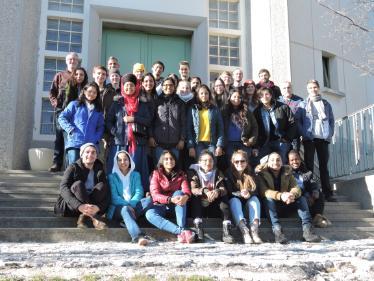
-
Air quality professionals from the team at DPIE visited the COALA-JOEYS campaign site near Cataract Dam for a tour of AIRBOX and the other measurements taking place during the nine week campaign.
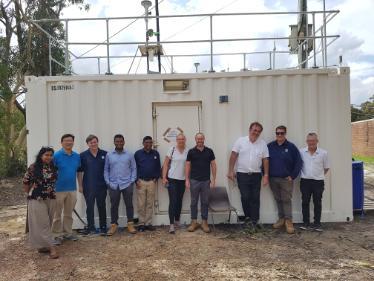
- PhD student Jesse Greenslade officially completed his PhD. Jesse is now an intern at the Australian Bureau of Meteorology.
- CAC takes possession of new lab and roof top building in Molecular Horizons. Photo shows Steve Wilson explaining the sun angles that we can view from our new location.
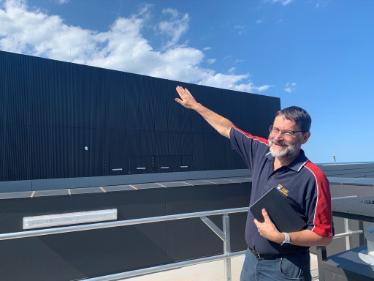
- Steve Wilson and Clare Murphy gave various interviews to journalists interested in the composition of the smoke from the bushfire crisis, including an ABC Illawarra radio interview (Steve) and a buzzfeed interview (Clare)
- The COALA-JOEYS field campaign starts! This is a major international atmospheric chemistry campaign aimed at understanding the emissions of chemicals into the atmosphere from trees and soils and the subsequent chemistry that forms fine particulate matter and ozone. The campaign involves a collaboration between UOW researchers from the CAC and CSES, University of Sydney, CSIRO, ANSTO, DPIE, Georgia Tech USA, Nagoya University Japan, Lancaster University UK and University California Irvine USA. In the first weeks of the campaign the site near Cataract Dam was impacted by smoke plumes from the nearby bushfires. The measurements made during these bushfires events will almost certainly comprise the most comprehensive chemical composition measurements ever made in smoke from Australian bushfires. The data is likely to be of great interest to those studying the long term health effects of exposure to the smoke suffered by so many Australians this summer.
Highlights 2019
- November 2019
- October 2019
- September 2019
- August 2019
- July 2019
- June 2019
- May 2019
- April 2019
- March 2019
- February 2019
- January 2019
- PhD student Beata Bukosa officially completed her PhD. Beata is now a postdoc at NIWA in Wellington, New Zealand.
- Frances Phillips (pictured) and Clare Murphy gave talks at the CASANZ NSW branch annual meeting in Sydney
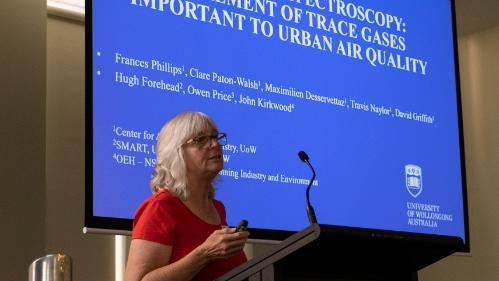
-
Most staff and student members of CAC gave presentations at the Atmospheric Composition & Chemistry Observations & Modelling Conference (incorporating the Cape Grim Annual Science Meeting 2019) at CSIRO Oceans and Atmosphere, Climate Science Centre in Aspendale.
-
CAC Director Clare Murphy attended the International Global Atmospheric Chemistry Scientific Steering Committee in Mexico City to discuss priorities for supporting atmospheric chemistry towards a sustainable future.
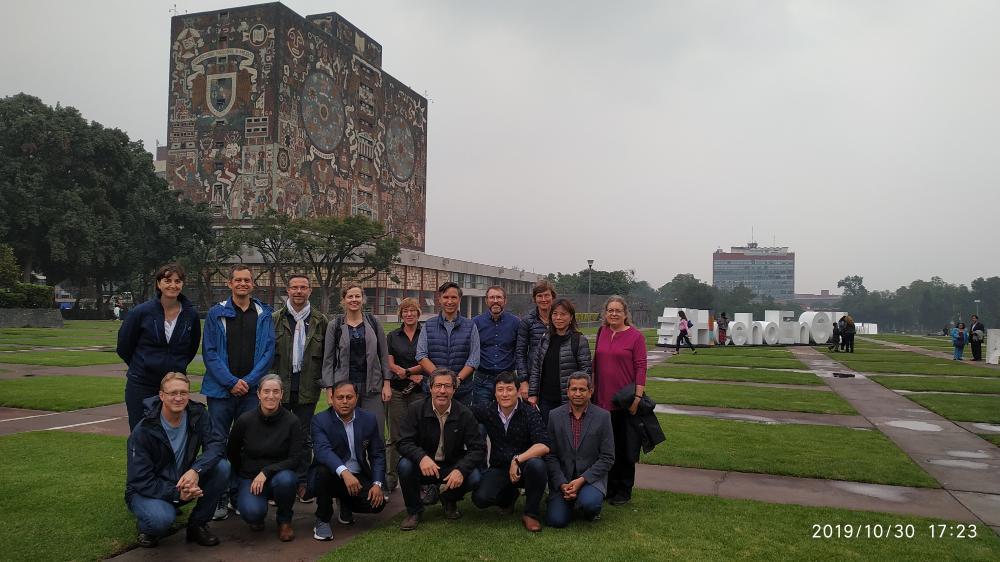
- Dave Griffith travelled to Brisbane to install instruments in AIRBOX aboard the RV Investigator which sets sail for a long summer voyage around to Freemantle via Darwin. AIRBOX will be measuring atmospheric composition across the tropics in the coming months. After docking in Freemantle, AIRBOX will be transported to Cataract for the COALA-JOEYS biogenics campaign.
- CAC students Susan, Jhonathan and Neil gave great talks at the inaugural SEALS postgraduate conference at Kioloa.
- Nicholas Deutscher elected as Deputy Director for the CAC cluster at group meeting.
- Travis Naylor and Hamish McDougall spent 3 days (October 2-4) at the Dutson Downs site, where we are operating a Spectronus as well as an open-path NIR instrument as part of the GipNet project. Travis and Hamish spent time doing general instrument maintenance, especially checking the performance of the OP-NIR after an incident involving some bulls. Hamish also took the opportunity to take several sets of VOC tube measurements near both the Spectronus and OP-NIR, to assess the VOCs potentially emitted from the organic recycling facility and a wastewater wetland.
- CAC Honorary Professor Ian Galbally is the joint lead author on a new paper "Tropospheric Ozone Assessment Report: Tropospheric ozone from 1877 to 2016, observed levels, trends and uncertainties"
-
Clare Murphy and Frances Phillips gave talks at the CASANZ conference in Queenstown, NZ where they presented work from the Clean Air and Urban Landscapes Hub on air quality in Sydney.
-
CAC major equipment grand bid, led by Nicholas Deutscher and titled “A new spectrometer to future proof the Atmospheric Remote Sensing Program at UOW” was awarded $250,000 in funding towards the cost of replacing the high resolution solar remote sensing spectrometer. If fully funded, the new spectrometer will be located on the atmospheric platform of the new Molecular Horizon’s building and will be run in parallel with the existing spectrometer for ~ 1 year to ensure compatibility of the time-series of atmospheric composition from Wollongong.
-
CAC staff including Graham Kettlewell got a peak preview of the new atmospheric research platform and laboratory on the top floor of the new Molecular Horizon’s building.
-
Volitaire Velazco travelled to Burgos to work on the TCCON site as part of the NASA CAMP2Ex campaign.
- Nicholas Deutscher, Graham Kettlewell and Nicholas Jones visited the Darwin TCCON site. During this time they successfully re-installed the solar tracker and finally re-commenced taking TCCON measurements. As an extension to the Fiducial Reference Measurements for Greenhouse Gases (FRM4GHG) project, they also took the UOW-developed Solar IRCube and an EM27/SUN and installed these on the roof of the container to allow for several months of comparative measurements, assessing the low spectral resolution instruments compared to the TCCON gold standard.
- Clare Murphy was interviewed by The Wire about The huge fires in the Amazon rainforest
- 2019 has seen 3 PhD students reach the end of their studies: Doreena Dominick, Bea Bukosa and Jesse Greenslade. We are looking forward to Doreena’s graduation in November, meanwhile Bea and Jesse are awaiting examiners comments on their theses.
- Members of the Centre for Atmospheric Chemistry and friends assembled for a seminar celebrating the first 5 decades of Dave Griffith’s scientific career. The event was held at Kiama on the eve of Dave’s 70th birthday.
- CAC Director Clare Murphy was interviewed as part of Chemistry World’s feature article on Wildfires and Atmospheric Chemistry.
- Vicarious radiometric calibration of passive optical instruments from satellites is carried out on the large homogeneous desert environment in Nevada, USA. A new paper published in ESSD (Velazco et al., 2019) presented the opportunities that Alice Springs, Australia could offer in the context of satellite surface products and associated emissivity assessments. In addition to near-undisturbed atmospheric conditions, the desert environment provides high surface reflectivity, which is needed for satellite validation purposes. By investigating measurements over the Australian desert from Japan’s Greenhouse Gases Observing Satellite (GOSAT) and using a portable FTIR spectrometer with a UOW-built fairing and clamshell cover to endure the harsh desert conditions, the UOW team made the first steps in making desert Australia a potential future site for validation of space-based sensors.
- Breaking the Tie: Burgos TCCON. NASA highlights the quality and importance of the Burgos TCCON data (Velazco et al., 2017) in improving the recent version 9 ACOS retrieval algorithm for OCO-2 at the 15th International Workshop on Greenhouse Gas Measurements from Space (IWGGMS-15), held in Sapporo, Japan. Dr. O’Dell from the NASA ACOS team stated that “Space-based measurements of the column-mean dry air mole fraction of carbon dioxide (XCO2), if made with sufficient accuracy and precision, offer a potential goldmine of information on CO2 surface fluxes at both small and large spatial scales. However, possible biases in satellite XCO2 will create spurious fluxes and are a limiting factor in utilizing these data” (O’Dell et al., 2019, IWGGMS 15 Abstract Collection). In their presentation, Burgos TCCON was shown to be excellently situated to “break the tie” in bias estimates to within 0.5 ppm-1.0 ppm
- UOW was ranked in the top 75 universities for Atmospheric Sciences in the world in the Shanghai Ranking's 2019 Global Ranking of Academic Subjects.
- What is the effect of ozone depletion, and the response - the Montreal protocol - that was agreed upon internationally? Two UOW scientists, Stephen Wilson from CAC and Sharon Robinson, are authors of a new review of the answer to this question in Nature Sustainability. The work highlights the impact of the ozone hole on the southern hemisphere climate, an interaction that was not recognized back when the original agreements were signed. While significant changes have been identified, these have been limited by global action: the world avoided would have been much less hospitable for life.
- CAC researcher Clare Murphy spent time on study leave in the UK visiting collaborators at the London School of Economics, Cranfield University and the UK’s National Physical Laboratory before heading home to Wollongong via the iCACGP meeting in Montreal. She is pictured here with Professor Neil Harris at Cranfield University during a visit to the FAAM airborne laboratory.
- After two years of successful operation and the validation within EMeRGe-Asia, the Burgos TCCON station has been recognized as a “full” TCCON station by the TCCON steering committee at the annual meeting held in Wanaka, New Zealand. Within the EMeRGe campaign in Asia, profiles of CO2 and CH4 measured on board of the "High Altitude and Long Range Research Aircraft" (HALO) were provided to the Burgos TCCON station in order to fulfil this requirement. This is a significant contribution to TCCON and to the validation of space-based greenhouse gases remote sensing satellites like GOSAT, GOSAT-2, OCO-2, TROPOMI, etc., as well as to science in Southeast Asia.
- A new paper on CO2, CH4 and CO distribution, sources and sinks and their co-variation in the Australian region led by CAC PhD student Beata Bukosa was published in Atmospheric Chemistry and Physics. The authors used shipborne measurements of the carbon greenhouse-gases together with the GEOS-Chem model to quantify and constrain the processes driving the changes of these gases. Their results point to overestimates of CH4 from coal burning and underestimate of all three gases from biomass burning. They also identified missing sources from fossil fuel, biofuel, oil, gas, coal, livestock, biomass burning and the biosphere in the model, pointing to the need to further develop and evaluate greenhouse-gas emission inventories for the Australian continent. Other CAC co-authors include Nicholas Deutscher, Jenny Fisher, Clare Murphy and David Griffith.
- CAC researcher Jenny Fisher was awarded third place as a finalist in the Australian round for the ASPIRE Prize. The APEC Science Prize for Innovation, Research and Education (“ASPIRE”) is an annual award which recognizes young scientists who have demonstrated a commitment to both excellence in scientific research, as evidenced by scholarly publication and cooperation with scientists from other APEC member economies.
- The annual joint Total Carbon Column Observing Network (TCCON) and Network for Detection of Atmospheric Composition Change- InfraRed Working Group (NDACC-IRWG) Meeting was held from May 19-23 in Wanaka, New Zealand, hosted by the New Zealand National Institute for Water and Atmospheric Research (NIWA). Around 50 experts from these networks gathered to discuss scientific progress and future directions, and to represent their TCCON and NDACC measurement sites. TCCON co-chair and deputy chair, David Griffith and Nicholas Deutscher, attended the meeting, along with site PIs Voltaire Velazco and Nicholas Jones. They were joined by former CAC Phd student Beata Bukosa, in her first week in a new role working as a postdoctoral fellow for NIWA. All CAC representatives presented and contributed to running sessions within the meeting. During the meeting, the Burgos TCCON site, co-operated by CAC, NIES, and EDC, was elevated to full TCCON status by unanimous approval of the TCCON steering committee.
- CAC PhD student Beata Bukosa and researcher Jenny Fisher attended the 9th International GEOS-Chem Meeting (IGC9) at Harvard University. Beata presented her work developing a new model capability to simultaneously simulate multiple carbon greenhouse gases, and both attended the myriad talks, posters, clinics, and model development working groups. Jenny also attended the GEOS-Chem Steering Committee meeting held after the conference.
- OCO-3, the Orbiting Carbon Observatory 3 satellite, launched successfully from Cape Canaveral on Saturday 4th May on its way to the International Space Station. CAC researchers are closely involved in the validation of OCO carbon dioxide measurements.
- CAC researcher David Griffith presented an invited lecture on the impact of isotopic variations on measurements of atmospheric greenhouse gases at the European Geophysical Union 2019 General Assembly. He also presented papers on open-path FTIR greenhouse gas measurements as part of the Gipnet project for detecting fugitive GHG plumes, and solar remote sensing at the Burgos, Philippines site (all with other UOW coauthors).
- CAC researcher David Griffith visited the Korean Research Institute for Standards and Science (KRISS, S. Korea) and Laboratory for Science of Climate and Environment (France) to advise and collaborate on applications and use of the UoW-Ecotech Spectronus Greenhouse Gas analyser and on solar remote sensing measurements. The Spectronus is being introduced into the pan-European ICOS (Integrated Carbon Observing System) greenhouse gas measurement and research programs.
- Whilst at Macquarie Island, CAC members Clare Murphy and Alan Griffiths undertook some checks and tests on the instruments in the Clean Air Lab, including lowering and checking on the inlet mast and leak checking the radon detector.

- CAC members Clare Murphy and Alan Griffiths were the Voyage 4 researchers aboard the Australian Antarctic Divisions Aurora Australis resupply voyage to Macquarie Island as part of the CAMMPCAN project. In addition to running the AIRBOX suite of instruments in the Southern Ocean, the team captured an interesting dataset at port in Hobart as the city was impacted by the recent Tasmanian fires. This may be the most comprehensive set of aerosol phase measurements ever made within a smoke plume in Australia.


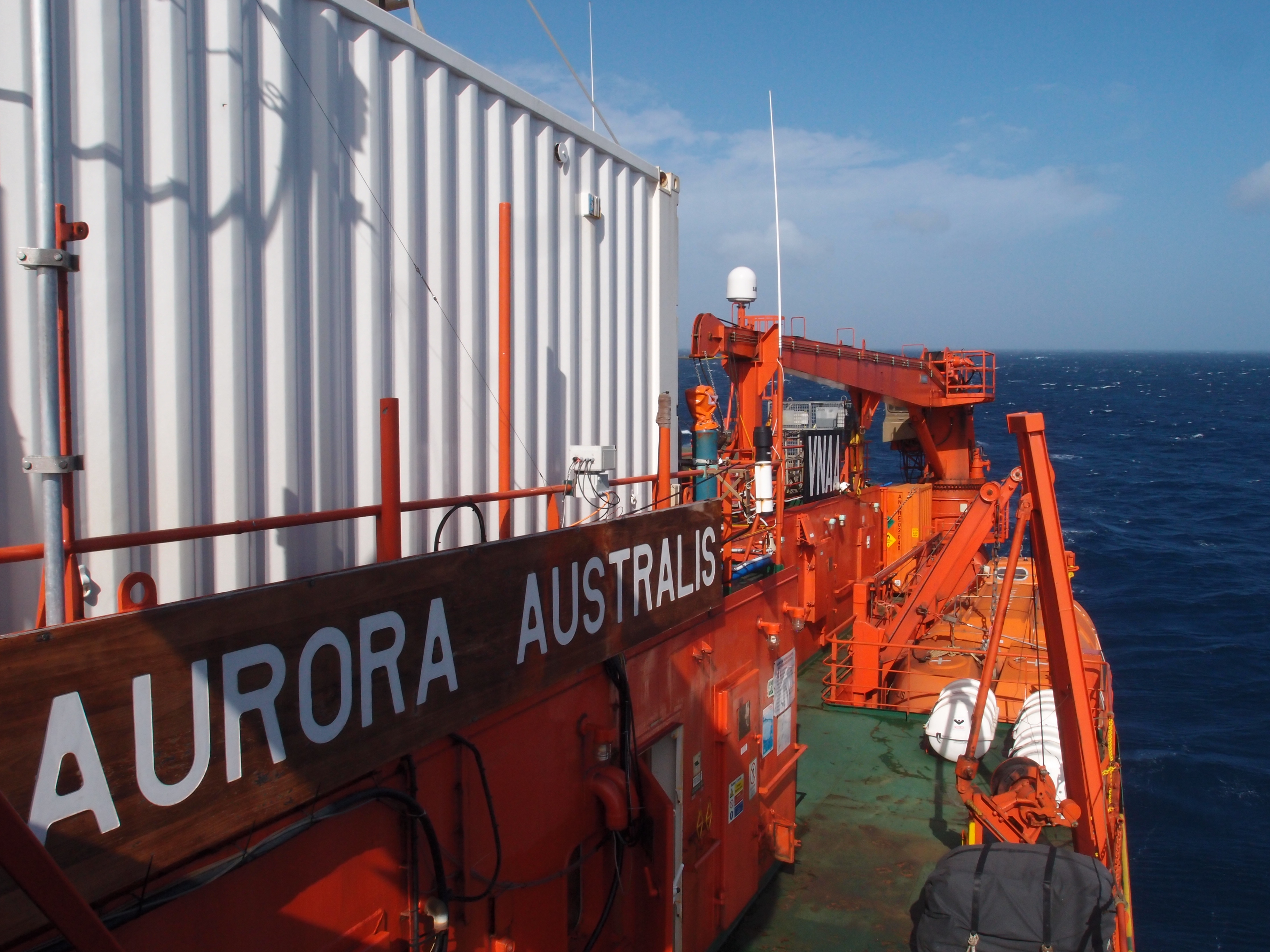
- CAC researcher Voltaire Velazco presented his work and talked about adventures in the field at the Uni in the Brewery event, along with two colleagues from the School of Earth, Atmospheric, and Life Sciences (Marian Wong and Dominique Tanner). Watch the event online!
- CAC welcomed two new PhD students. Jhonathan Ramirez Gamboa will focus on the COALA-JOEYS campaign and improving our understanding of biogenic emissions in southeast Australia, and Shyno Susan John will focus on variability of carbon monoxide in Australia from satellite and ground-based measurements.
- The new Mercury Australia network was launched at ANU on 28 March 2019. The network brings together 20 researchers from eight universities across Australia, including CAC researcher Jenny Fisher, who are investigating the historical and contemporary uses and impacts of mercury. The network will engage with government, industry, and the public to provide high quality, independent data and information that can be translated to practical policy advice.
- The 4-yearly scientific assessment of the impact of Ozone Depleting Substances has just been published both by the UN and in the scientific literature (Photochemical and Photobiological Sciences). The review of the impact on Air Quality was led by CAC member Stephen Wilson. The University of Wollongong played a large role in this report overall, as in addition to this lead authorship Sharon Robinson (biology) was co-author of two other assessments. No other university is represented so heavily.
- CAC researcher Voltaire Velazco attended the CAMP2Ex (Cloud, Aerosol and Monsoon Processes Philippines Experiment) science team meeting in Pasadena, California ahead of the CAMP2Ex aircraft experiment taking place in Southeast Asia in August. Voltaire's role involves getting flights over the TCCON site at Burgos, and complementing the campaign's science objectives with ground-based FTIR and LIDAR measurements.
- The Aurora Australis is due to set sail for the sub-Antarctic Macquarie Island on 5 March, with CAC director Clare Murphy and CAC associate member Alan Griffiths on board. Very high seas are predicted for the transit. The atmospheric chemists will be busy onboard measuring a diverse array of trace gases and particulate parameters using the AIRBOX mobile laboratory, with the goal of better understanding the process of aerosol formation over the southern ocean.
- PhD student Neil Page attended the one-month European Research Course on Atmospheres (ERCA) held in Grenoble, France with participants and lecturers from all over the world. ERCA covers the physics and chemistry of the atmosphere, the climate system and atmospheric pollution. The program also includes group projects; practicals using lidars, spectrometers and models; and a research visit to the Observatoire de Haute-Provence for astronomical observations. Neil followed ERCA with a research visit to collaborator Aurélien Dommergue at the Institut des Géosciences de l'Environnement.
- Over the summer, CAC hosted three undergraduate researchers. Chris Nelson has been undertaking a SMAH Summer Scholar project with Nicholas Deutscher working on atmospheric AirCore profiling. Chris is a recent chemistry graduate from the University of Queensland. He has been joined in laboratory and field testing and sampling by Alex Carter, a 2nd/3rd year undergraduate chemistry intern. Chris and Alex have been developing the horizontal AirCore sampling technique to improve precision and reduce the effects of contamination. They have also been sampling in situ in the Wollongong area, exploring methane hotspots, as well as testing components for upcoming balloon-borne AirCore launches. Brittany Walker, who recently completed her 1st year in Atmospheric Science, has been working as an intern with Jenny Fisher, updating and modernising the software package used to benchmark the GEOS-Chem mercury model.
- Members of CAC checked out the location of the new atmospheric platform on top of the Molecular Horizon’s building – agreeing the last details before the concrete floor was poured!